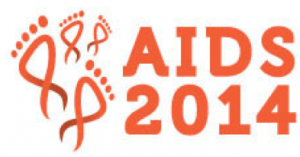UNAIDS sets 90-90-90 target for 2020 to end AIDS by 2030
1 August 2014. Related: Conference reports, Treatment access, World AIDS 20 Melbourne 2014.
 Simon Collins, HIV i-Base
Simon Collins, HIV i-Base
The AIDS 2014 conference was notable for the launch by UNAIDS of a strategy with a target of eliminating AIDS by 2030. [1]
This included a 90-90-90 campaign outlined in report detailing new targets for testing and treatment. [2]
The target refers to three key steps that are essential to both better health and care for HIV positive people and to limiting new infections and the further spread of the HIV pandemic.
- 90% of all people living with HIV should know their status. Currently, 19 million people globally are estimated to be HIV positive and are not aware of their HIV status. [3]
- 90% of all those who are diagnosed HIV positive to be on sustained antiretroviral treatment (ART). While global access has advanced tremendously, with over 14 million people on treatment, double this numbers should be eligible for treatment in low- and middle income countries based on WHO 2013 guidelines that recommend a CD4 threshold of 500 cells/mm3 to initiate treatment. Using a “test and treat” model, increases the number of people eligible for treatment to 34 million. The emphasis on “sustained” ART is to ensure that supply of medicines is no longer vulnerable to stock-outs.
- 90% of those on ART having an undetectable viral load. This highlights both the importance of wider access to viral load monitoring and the importance of viral suppression as a major goal of ART. This also recognises the dramatic reduction in transmission risk once viral load is undetectable.
The targets are ambitious, which is intentional.
In 2002, the “3×5” target to get three million people on treatment by 2005 was seen as dramatically over ambitious by most people in terms what was achievable in practice and yet woefully inadequate in terms of a global health response. But the target set the momentum for scale up and although is took slightly longer to achieve than 2005, looking back we see the 3 million as something we sailed past years ago.
By December 2013, approximately 12.9 million people were on ART with the target of 15 million people by 2015 roughly on track.
The UNAIDS report highlights additional challenges including the differences between countries in terms of current coverage, for children as well as adults. For example, currently only 41% of babies born to HIV positive mothers have access to early testing and only ten ARVs are available in paediatric formulations.
Although the report focuses almost exclusively on low- and middle-income countries, these targets are likely to be a challenge in all settings, including wealthier countries that have widely different treatment cascades.
References:
- UNAIDS. Press statement. Global leaders commit to ending the AIDS epidemic in cities by 2030. (20 July 2014).
http://www.unaids.org/en/resources/presscentre/pressreleaseandstatementarchive/2014/july/20140720cities - UNAIDS. Ambitious treatment targets: writing the final chapter on the AIDS epidemic. (July 2014).
http://www.unaids.org/en/media/unaids/contentassets/documents/unaidspublication/2014/JC2670_UNAIDS_Treatment_Targets_en.pdf (PDF)

